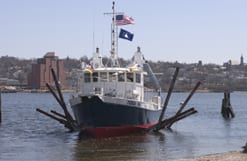WHOI Launches Coastal Vessel Tioga
April 14, 2004
The Woods Hole Oceanographic Institution’s new 60-foot coastal research vessel (CRV) Tioga was christened and launched March 29, 2004 in ceremonies at Gladding-Hearn Shipbuilding, Duclos Corporation in Somerset, MA.
The vessel is expected to arrive in Woods Hole soon and will undergo final outfitting and testing before beginning its operating schedule for science and education.
“Support for access to the sea is a high priority within the Institution,” said WHOI President and Director Robert B. Gagosian. “Our scientists, engineers and students need capable research vessels to transport them into the ocean to conduct research, whether it be the coastal zone or the deep sea.”
Construction of the new coastal vessel began in April 2003. Designed by Roger Long Marine Architecture, Inc. of Cape Elizabeth, Maine, the CRV Tioga offers researchers many expanded capabilities, including a cruising speed of 20 knots, providing efficient and quick access to coastal waters including Martha’s Vineyard and Nantucket sounds and Massachusetts Bay. It can operate within a narrow weather window, as little as four hours, for distances up to 350 miles, which would enable it to reach New York harbor and the Gulf of Maine, where a number of Institution staff are conducting research projects.
The new vessel can accommodate six people for overnight trips or up to 10 people for day trips. At approximately $2,000 a day, its day rate is very competitive, making it a cost-effective platform for instrument testing, coastal studies and educational programs.
Tioga provides high-quality diver support including a dive platform, dive locker and shower. It will be able to handle complex instrument arrays and coastal moorings through a 10,000 lb. stern A-frame, and its versatile fantail and booms will enable scientists and engineers to tow new instrument systems. Among the standard instrumentation planned for the vessel are a flow-through water sampling system, a full suite of meteorological measurement systems (IMET), an acoustic doppler current profiler (ADCP) and conductivity/temperature/density (CTD) with winch for a variety of physical oceanographic measurements, and clean power.
Rocky Geyer, chair of the Institution’s Applied Ocean Physics and Engineering Department and head of the science advisory committee for the vessel, says Tioga will enable many students to gain invaluable research experience at sea, provide quick access to coastal areas throughout the northeast, and enable scientists to conduct research on a variety of topics, from marine mammals and harmful algal blooms to coastal erosion, storms and oil spills.
Tioga’s diver support will be a major asset for the extensive diving activity at the Martha’s Vineyard Coastal Observatory, one of the vessel’s major destinations. Large instruments like buoys can be put into the water through the stern A-frame, which is similar in size to those on WHOI’s large ships.
“Tioga can get to the edge of the continental shelf and back in daylight.” Geyer says. “This is great for the scientists who need to test their instruments in deep water. Having this capability is going to be a boon to the blue-water oceanographers who are trying to get to the next level in technological innovation. But the most important impact of Tioga will be in the science of our coastal environment. This is the dawn of WHOI’s greatest era in coastal research.”
Gladding-Hearn Shipbuilding, a family-operated business, has built more than 340 high-quality commercial vessels since 1955 and is renowned for its ability to design and build unique and specialized craft such as fast ferries, police and fire boats, pilot boats, tug boats, fishing boats, research vessels and other distinctive vessels. Tioga is the 344 th vessel built by the shipyard, which has a number of vessels under contract and has built similar research vessels for the University of New Hampshire and Old Dominion University.
WHOI is a private, independent marine research and engineering, and higher education organization located in Falmouth, MA. Its primary mission is to understand the oceans and their interaction with the Earth as a whole, and to communicate a basic understanding of the ocean’s role in the changing global environment. Established in 1930 on a recommendation from the National Academy of Sciences, the Institution is organized into five departments, interdisciplinary institutes and a marine policy center, and conducts a joint graduate education program with the Massachusetts Institute of Technology.

